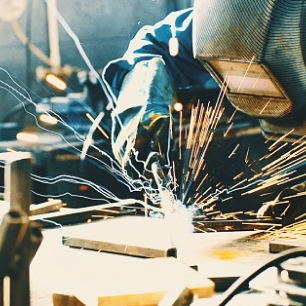Jump to:
Laser Vision Scanning of Welds
The November 2020 Inspection Trends featured an article titled “Using Portable Laser Vision to Improve Weld Quality,” written by myself, a Certified Welding Inspector (CWI) at Crown Equipment Corp., New Bremen, Ohio, and Jeff Noruk, president of Servo-Robot Corp., Wauwatosa, Wis., which explained the foundational benefits of incorporating portable laser vision inspection into a weld quality control program. Crown Equipment Corp., one of the world’s largest forklift and material handling companies, acquired this technology to enhance its manufacturing while producing robust, ergonomic, and safer equipment.
Fast-forward over three years and we have experienced additional benefits that have been realized over time. The rapid evolution of welding technology demands an equal progression of quality control, measurement accuracy, and digital data output that can only be captured and realized by laser technology, using, for example, a handheld laser vision scanner and weld quality system — Fig. 1.
Backstory
Having personally welded for 20 years at many large and small organizations, then progressing to weld inspection for over 20 years at Crown, I acquired the experience of being very up-close and personal with tens of thousands of welds on both sides of the manufacturing aisle. Understanding that each weld in the world is unique and distinct brings with it a sense that there must also be an equally distinguishing method to validate a weld’s conformance to applicable standards and codes. With the ever-increasing changes in the manufacturing world, whether due to ergonomics, economics, or other factors, welding and welding joints are continuously evolving. I found a need for a more versatile and reliable method of visual weld inspection, such as laser vision.
The November 2020 Inspection Trends article touched on general weld inspection. In the article, laser vision scanning was compared to the traditional manual weld gauges, and inspecting unconventional weld types, such as skewed T-joints, was discussed. Weld features that are difficult to quantify were also considered, such as reentrant angles (at the weld toes) and undercut depths. The article also discussed the safety benefit of laser vision inspection due to its ability to measure hot parts without contact and its intuitive reporting capabilities, including digital data, vivid images, and cross-sectional graphics.
Discovery
I would like to highlight the accuracy of laser scanning by comparing it to the more traditional methods of inspecting welds using conventional, manual weld gauges. We’ll start with a story about my real-world experience.
During an audit I performed to validate weld sizing and quality on robotically welded test samples, I inspected a fillet weld produced in the horizontal position (2F) with the specified weld size of 0.375 in. (9.53 mm). As you may know, welds deposited in the horizontal position, or any position that deviates from true flat, generally exhibit some gravitational sag. Proficient manual welders or robotic programmers can mitigate some of this sag through equipment settings and welding techniques, but eliminating it isn’t easy. Gravity is ubiquitous and causes weld face profiles to deviate from the desired flat profile, even to a small degree.
To inspect this fillet weld, I utilized the weld leg size corner of a traditional fillet weld gauge. The horizontal and vertical weld legs met the minimum weld leg size. Turning the gauge appropriately to validate the theoretical weld throat with its center tab revealed that it met the minimum required size. Or did it? — Fig. 2.
The center tab contacted the face of the weld, which typically validates that the theoretical weld throat meets the minimum size specification. However, I was curious about the concave area between the center of the weld and the vertical weld toe. Typically, the fillet weld size for equal leg fillet welds is defined as the leg lengths of the largest isosceles (two legs of equal length) right-angle triangle that can be inscribed within the fillet weld cross section. I wondered what the calculated fillet weld size would be. Fortunately, I had access to laser technology that would provide quantitative digital values to validate the results of the manual gauge inspection.
Plan
Without laser vision scanning, I would have had to cut this sample and examine it closely under magnification (macroetching). Because I had access to laser scanning, I used both methods to evaluate this weld. If the inspection equipment performed as claimed — that is, to automatically inscribe the largest isosceles right-angle triangle by the incorporated algorithm — I would be able to compare and validate laser scanning and magnification results for accuracy.
I started with the laser scanner. After reading the operation manual and familiarizing myself with its software, I created a program for a 0.375 in. fillet weld and measured it. There were a few graphical icons that turned red (revealing nonconformance). Most were green. These results tentatively supported my suspicion about the quality of this weld. Next, I needed to validate this by sectioning and macroetching the part in the same area. I was excited, thinking that now we might have a way to substantiate and validate what, up until now, was mere suspicion on our part. I sectioned the sample, performed a macroetch, and measured the weld. The results can be seen in Fig. 3.
Accuracy
The laser profile graphic in the upper right corner of Fig. 3 is a cross-sectional graphic showing the laser scanning results. The yellow line represents the profile of the weld face utilizing a 2D point line. The blue, large isosceles right-angle triangle inscribed within the weld touches the weld face at the lowest point of concavity. This represents the adjusted, or actual, true weld size. The laser output data section displays what is being measured along with the numerical results. The large macroetched view on the left in Fig. 3 was measured by alternate, dedicated weld inspection equipment after the part was sectioned and acid etched.
Table 1 shows the results of five key measurements made using two different validation techniques, sectioning and macroetching versus laser scanning. The colors indicated correspond to those shown in Fig. 3.
All measurements using the two methods were comparable to within 0.003 in. (0.08 mm). This is exceptional and falls within the measurement precision of 0.005 in. (0.13 mm) for the laser scanning unit that was used.
The laser scanner automatically calculated the adjusted weld size with the incorporated algorithm based on the theoretical weld throat. This resulted in a final adjusted weld size of 0.365 in. (9.27 mm), which fell short of the required minimum weld size of 0.375 in. (9.53 mm). You may have noticed that the horizontal and vertical weld legs were swapped for the laser scanner results. This was caused by the orientation of the scanning device to the weld, but it did not affect the overall test result.
Supplemental data captured and displayed by the laser scanner included the angle between the base metal plates (88 deg) and the angles between the weld faces and the adjacent base metals at the weld toes (105 and 140 deg). These measurements also helped validate that the base material angles met specifications and revealed overlap or toe angles that might meet more stringent specifications per applicable code. It also outputted an over-welding percentage (dollar sign icon showing 35% below it) based on the minimum leg size tolerance set and zero convexity, which could help identify opportunities for cost savings.
While this example suggests that the slightly undersized weld was a cause for rejection, there are many factors considered in the pass/fail disposition of a weld. The weld size needs to be assessed for the entire weld length. Each discontinuity along that length must also be incorporated into the decision matrix to determine if it is a rejectable defect. Your company’s code associated with this weld will provide guidelines for pass/fail criteria, with specific tolerances for weld size and the number of variations allowed within the length of the weld.
With such stringent requirements and specifications, using an equally capable inspection method is even more imperative. Inspection with manual weld gauges has its place, and the tools used are always improving. However, there are cases where manual inspection cannot attain the accuracy that newer technologies achieve, especially as companies continue to refine their codes. Laser scanning can achieve this level of accuracy and provide the digital data to support it.
Another Test Example
To help validate the experience of the first test above, I performed the same comparison testing for groove and skewed T-joint welds, as shown in Fig. 4. Pass/fail tolerances were not programmed into the laser scanner in this example.
For the groove weld, the laser scanner’s weld profile graphic reveals the cross-sectional shape of the weld face. The blue triangulation noted above is not utilized with groove welds, so it is not part of these results. Two measurements were chosen to be evaluated through macroetching. Laser scanning captured these results; the additional measurements are shown in Table 2. The two measurements taken by both methods were comparable to within 0.001 in. (0.03 mm).
A similar comparison was also conducted for a skewed T-joint weld. In the laser’s profile graphic, the blue triangulation is no longer a right-angle triangle but is still an isosceles triangle. Note that in the case of a specified unequal leg fillet weld, there is the option to inscribe the largest nonisosceles triangle within the weld cross section to facilitate correctly calculating the weld size and theoretical throat measurements. Notice that the weld leg on the vertical base material member is longer than the horizontal member’s. These cross-sectional graphics are easily understood and can be a good way to present ambiguous concepts and data to manufacturing personnel for process improvements.
Again, five measurements are specified and displayed in Table 3. All five measurements match to within 0.003 in. Supplemental data captured via laser scanning included weld toe angles and joint angle.
These tests made it clear that laser scanning could produce results similar to sectioning and macroetching but with more speed and accuracy and the ability to capture additional supplemental data. This capability assists our operations in tracking processes and trends and informing continuous improvement plans designed to achieve and maintain Six Sigma weld quality.
Additional Attributes of Laser Scanning
Laser scanning may help an operator better locate the weld position. Laser imaging utilizes a set of breakpoints that the laser searches for that best represent the base metals and what it sees as the weld toes and weld face profile. In some instances of nonstandard welds, the scanner may not properly represent the weld’s cross section. This is usually discernable directly after having performed an inspection by viewing the profile graphic and roughly assessing weld toe locations. Moving the breakpoints to the proper locations, using the available magnification levels, if necessary, helps to locate the best breakpoint placement. In addition, weld features are updated automatically.
Conclusion
In today’s highly automated and technologically developed world, we can live on the 52nd floor of a new high-rise, drive on a quarter-mile-high suspension bridge, and dive into the ocean depths in a submarine. What do these things have in common? They all require welding. No matter the activity, we expect and deserve to be safe. Manufacturing codes were created to help keep us safe. Technologies have been developed to help ensure we are safe. Laser scanning is one of these technologies designed to ensure that the things we live in, drive on, and dive in are structurally safe and secure.
WALT BYLSMA (walt.bylsma@crown.com) is an AWS CWI and Level III inspector at Crown Equipment Corp., New Bremen, Ohio. JEFF NORUK (j.noruk@us.servorobot.com) is president of Servo-Robot Corp., Wauwatosa, Wis.


